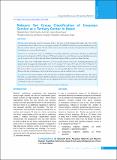Please use this identifier to cite or link to this item:
https://hdl.handle.net/20.500.14356/1056Full metadata record
| DC Field | Value | Language |
|---|---|---|
| dc.contributor.author | Baral, Gehanath | - |
| dc.contributor.author | Shrestha, Alish | - |
| dc.contributor.author | Sah, Arati | - |
| dc.contributor.author | Gupta, Aswani Kumar | - |
| dc.date.accessioned | 2023-04-20T10:25:48Z | - |
| dc.date.available | 2023-04-20T10:25:48Z | - |
| dc.date.issued | 2021 | - |
| dc.identifier.citation | BaralG., ShresthaA., SahA., & GuptaA. K. (2021). Robsons Ten Group Classification of Cesarean Section at a Tertiary Center in Nepal. Journal of Nepal Health Research Council, 19(1), 91-96. https://doi.org/10.33314/jnhrc.v19i1.2694 | en_US |
| dc.identifier.issn | Print ISSN: 1727-5482; Online ISSN: 1999-6217 | - |
| dc.identifier.uri | http://103.69.126.140:8080/handle/20.500.14356/1056 | - |
| dc.description | Original Article | en_US |
| dc.description.abstract | Abstract Background: Increasing trend in Ceasarean birth is the issue of both demand and supply side. One of the recommended tools to characterize every pregnancy admitted for childbirth is Robson ten-group classification system that may evaluate obstetric practice. The aim of the study was to assess the cesarean section pattern based on Robson’s classification in a central referral hospital. Methods: A retrospective census of childbirths at Paropakar Maternity and Women’s Hospital in Kathmandu performed from September 2018 to February 2019 based on obstetric record. Robson ten-group classification system was the research tool to collect data and Robson Classification Report Table was used to evaluate the data. Results: There were 10500 births with 34% (32-35%) overall cesarean section rate. Excluding spontaneous and induced labor the supposedly total prelabor CS is 14.5%. Group 1+2+3 size is 81% and 21% CS; 5+10 had 11.3% and 23.3% respectively. Prelabor CS (2b+4b) is 3.54% and additional 11% from malpresentation and preterm. Group CS rate from Class 5 onwards, and ratio of 1 and 2 are as recommended by Robson; 67% of CS were not picked up by Robson class due to indications evolved as the labor progresses and the attributes not pre-classified. Conclusions: The assessed quality of data and the type of obstetric population by Robson reference values prove this study as a representative research. But the indications of cesarean sections can be predicted for only one-third of pregnancy attributes classified by Robson class. To supplement this tool to reduce rising cesarean birth requires audit of indications at decision making level. Keywords: Cesarean section; indication; prediction; robson classification | en_US |
| dc.language.iso | en | en_US |
| dc.publisher | Nepal Health Research Council | en_US |
| dc.relation.ispartofseries | Jan-March, 2021;2694 | - |
| dc.subject | Cesarean section | en_US |
| dc.subject | Indication | en_US |
| dc.subject | Prediction | en_US |
| dc.subject | Robson classification | en_US |
| dc.title | Robsons Ten Group Classification of Cesarean Section at a Tertiary Center in Nepal | en_US |
| dc.type | Journal Article | en_US |
| local.journal.category | Original Article | - |
| Appears in Collections: | Vol. 19 No. 1 (2021): Vol. 19 No. 1 Issue 50 Jan-Mar 2021 | |
Files in This Item:
| File | Description | Size | Format | |
|---|---|---|---|---|
| 2694-Manuscript-21556-1-10-20210425.pdf | Fulltext Article. | 406.01 kB | Adobe PDF |  View/Open |
Items in DSpace are protected by copyright, with all rights reserved, unless otherwise indicated.
